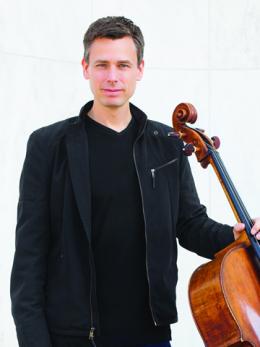by Mike Telin

But having recently completed Da Pacem, his new concerto for cello and orchestra, the Grammy-winning composer said he feels “a little more serene” than when he began the work. “I had a lot of fun writing the piano concerto, but that was more of a violent roller coaster, while this piece seeks closure.”
On Wednesday, December 12 at 8:00 pm in Finney Chapel, cellist Darrett Adkins will perform the world premiere of Da Pacem with the Oberlin Orchestra under the direction of Robert Spano. The program will also include Jennifer Higdon’s Concerto for Orchestra. (Da Pacem was commissioned by Oberlin College and Conservatory, the Saint Paul Chamber Orchestra, the Aspen Music Festival, and the American Composers Orchestra.)
In his program notes, Hartke writes that the 22-minute, three-movement concerto takes its title from a Latin hymn that begins “Grant peace in our day.” It is a reflection on these unsettled and unsettling times. As the work’s protagonist, the solo cellist journeys through a considerable variety of musical landscapes.
He goes on to explain that the first movement is built upon plainchant, both the Da pacem hymn and the chant fragment, In nomine, which formed the basis of a whole genre of English instrumental pieces from the Renaissance through the time of Purcell.
Hartke said that it was his use of the plainchant that caused him to dedicate the Concerto to musicologist Alejandro Planchart. “He is a very dear friend and was a professor of mine at Yale. I was in his early music group when I was an undergraduate there, and among the pieces we performed was a mass built on the plainchant Da Pacem. So, part of writing this piece is a gift to him.”
The composer noted that the scherzo, In diebus nostris (“in our day”), which has the tempo marking “nervous, haunted,”references a Venezuelan folk song. “When I was working on my Fourth Symphony that I wrote for Dudamel and the L.A. Phil, I had the idea of hiding little Venezuelan songs in the music so I asked Alejandro (who was born in Venezuela) to share some with me. Here in the second movement, which is a prayer for peace, I have this cheerful little tune being played in the orchestra while the cello is completely ignoring it. But the jovial innocence of the tune is enchanting to me.”
In the program notes, Hartke describes a tragic turn of fate: the central portion of the third movement is based on the protest song Ain’t you got a right to the tree of life? “While I was working on the close of this section, the news came about the massacre at the Tree of Life Synagogue in Pittsburgh, turning what had begun as an abstract musical elegy into a very real one.”

How much was Adkins involved in the composing process? “We consulted a little bit,” Hartke said. “I shared a sketch with him that now is at the beginning of the final movement. I asked him if what I wrote was possible and he said, ‘sure.’ But when somebody says ‘yes, I can do that,’ or ‘it will take some practice,’ occasionally I do ask ‘you say you can do it, but will it sound hard?’ I don’t want it to sound like the player is struggling.”
When writing a new piece of music, Hartke doesn’t push an idea that isn’t going to work. “You can justify anything with words, but that doesn’t mean you can justify it musically. I’m thinking back to the old days when the analysis of the piece was more important than the music.”
Did Hartke find the closure he was seeking in writing Da Pacem? “Yes, I think so,” he answered, contemplatively.
Published on ClevelandClassical.com December 7, 2018.
Click here for a printable copy of this article



